Smoke Alarm Installation Cost
Last updated 21st February, 2024
Need more information on fire alarms for homes?
All you need to know about the average cost of a fire alarm system installation, including the different types of fire alarm available, their costs and the price of hiring someone to install it.
Carry on reading below!

How Much Does Installing a Fire Alarm Cost?
The average cost of installing a fire alarm will depend on several factors; the type of alarm that you choose, the size of the fire alarm system, i.e. the number of alarms fitted, the location of your property and the complexity of the installation itself.
The fire alarm installation cost for an average home with two storeys will be in the region of £200-£250 for a combined optical smoke and heat alarm. An optical fire alarm is more expensive than an ionisation alarm but less prone to false alarms such as those activated by cooking.
A heat alarm is insensitive to smoke and is activated by an increase in heat so is suitable for kitchens. The cost of a combined alarm will be between £25-£60 each depending on the brand and whether it is battery or mains operated.
A more basic ionisation smoke alarm will cost as little as £5 and can be installed easily by most people. The minimum number of fire alarms in a property is recommended as one if it is single storey and two for a two-storey property.
These alarms are generally fitted in hallways and at the top of the stairs. A more complicated mains-operated fire alarm system will require the services of a qualified electrician and will cost on average £100-£150 in labour.
The ease of access to installing the necessary wiring will have an impact on the length of time the work takes and the associated labour cost.
For a mains-operated system, it is necessary to have a qualified electrician install your fire alarm system, and this cost will vary depending on where you live. A tradesperson will normally charge a higher rate for the first hour on-site, which then reduces for subsequent hours.
This is to cover expenses such as travel in the event that the job does not take very long and ensures that the tradesperson is not operating at a loss. Prices in London are always higher, and the hourly rate for an electrician in the capital is around £80-£120 for the first hour and approximately £40-£60 for subsequent hours.
In other parts of the country, this will be less with an average hourly rate for an electrician costing £60-£80 for the first hour and £30-£40 thereafter.
Table of Contents
- How much does installing a fire alarm cost?
- What is a fire alarm?
- Installing a fire alarm
- Cost affecting factors of installing a fire alarm
- DIY fire alarm
- Choosing a fire alarm
- Ionisation alarms cost
- Optical alarms cost
- Heat alarms cost
- Combined optical smoke & heat alarm cost
- Combined smoke & carbon monoxide alarm cost
- Benefits of a fire alarm
- Building regulations and planning permission for fire alarms
- Removing a fire alarm cost
- FAQs
- How to find & hire a fire alarm installer
- Sources
Fire Alarm Prices
These tables reflect the average cost of installing a minimum of two fire alarms.
Prices are for different types of both battery and mains operated fire alarms and the associated average labour cost of hiring an electrician or tradesperson.
| TYPE | MAINS OPERATED | LABOUR COST | TOTAL |
|---|---|---|---|
| Ionisation | £15 | £70-£100 | £100-£130 |
| Optical | £25 | £70-£100 | £120-£150 |
| Heat | £20 | £70-£100 | £110-£140 |
| Optical Smoke & Heat | £55 | £105-£150 | £215-£260 |
| Smoke & Carbon Monoxide | £50 | £105-£150 | £205-£250 |
How much you pay will also depend on the number of alarms fitted, the complexity of the installation and the location of your property. Battery operated fire alarms do not need to be fitted by an electrician.
| TYPE OF FIRE ALARM | BATTERY OPERATED | LABOUR COST | TOTAL |
|---|---|---|---|
| Ionisation | £5 | £40-£50 | £50-£60 |
| Optical | £15 | £40-£50 | £70-£80 |
| Heat | £15 | £40-£50 | £70-£80 |
| Optical Smoke & Heat | £25 | £60-£75 | £110-£125 |
| Smoke & Carbon Monoxide | £30 | £60-£75 | £120-£135 |
Supply Costs
Below is a price list of fire alarm systems of various types without the cost of labour or installation.
| TYPE OF FIRE ALARM | BATTERY OPERATED | MAINS OPERATED |
|---|---|---|
| Ionisation | £5 | £15 |
| Optical | £15 | £25 |
| Heat | £15 | £20 |
| Optical Smoke and Heat | £25 | £ 55 |
| Smoke and Carbon Monoxide | £30 | £50 |
Additional Costs
Most people understand the need to install a fire alarm in the home in order to protect lives and property.
The traditional battery-operated smoke alarm is still vital and popular for its simplicity and effectiveness, but more people are opting for hardwired fire alarm systems with battery backup.
Older Properties
While the majority of houses will be up to date with electrical compliance, some older properties may need either re-wiring or the installation of a new consumer unit.
This may be something you have to consider if you have purchased an older house and if there is no RCD on the fuse board.
Replacing a Consumer Unit
An RCD is a residual current device which monitors the flow of electricity and cuts off the supply if it detects the electricity travelling down an unintended path. This can prevent electrocution and electrical fires.
A fuse board with an RCD will have a button marked ‘T’ or ‘Test’ or a label which says, ‘test quarterly’. An older fuse board will have a wooden back, and this is a reliable indication that it should be changed.
The cost to replace your consumer unit with a new one will be in the region of £450.
Re-wiring a House
Whilst it is a large undertaking re-wiring an entire house may be necessary if your home has outdated wiring which could be potentially dangerous.
One of the many strains that modern demands put on older properties is the use of extension leads. As most older homes do not have the number of sockets that newer properties have, and that people nowadays expect extension leads.
Overloading the wiring can cause tripping of the fuse board or even electrical fires.
By adding a mains-operated fire alarm system, the load on the existing wiring may be excessive and cause problems, so it is worth considering re-wiring if you do have an older property.
The cost to re-wire an average three-bedroom semi-detached house is between £3,000-£4,000. Of course, this is dependent on the number of sockets and switches fitted, the number of electricians working on the job and the time it takes.
Cost Breakdown Calculator
Individual costs for installing two combined optical smoke and heat alarms: £260
Materials
£104
Labour
£156
Waste Removal
£0
Labour Costs and Time Frames
The labour costs for installing a fire alarm will depend on whether you install a battery-operated or a mains-operated system.
Battery Operated Fire Alarm Installation
A battery-operated fire alarm can be installed by a handyman or even as a DIY job as there is no wiring involved.
The cost of a general tradesperson who can carry out this work is between £20-£50 per hour depending on where in the UK you live. Installing a battery-operated fire alarm will take no more than an hour, two at the most for a two-storey property.
Mains Wired Fire Alarm Installation
A mains operated fire alarm will require the services of a qualified electrician, and depending on the number of alarms and the complexity of the installation, it may take 3-4 hours or more.
In London, the cost to hire a qualified electrician is between £80-£120 for the first hour and on average £40-£60 per hour beyond that.
For other parts of the UK, the prices charged by an electrician will vary with major cities being more expensive but will nevertheless be cheaper than London at around £60-£80 per hour initially falling to £30-£40 per hour thereafter.
What Would Increase the Cost and Timeframe?
While the minimum recommended number of fire alarms is one for a single level dwelling and two for a two storey home, some people prefer to have an alarm in each room.
The only place that does not really lend itself to a fire alarm is a bathroom. Clearly, an installation that involves every room will take longer and cost more in labour charges.
Mains operated systems will take longer than fitting battery-operated alarms, and some installations may require wiring to be cut or ‘chased’ into the walls of the property. This will mean not only that the installation will take longer but will also require the services of other trades such as a plasterer and decorator.
What is a Fire Alarm?
A fire alarm is a device that detects a fire and sounds an alarm to warn occupants in a building.
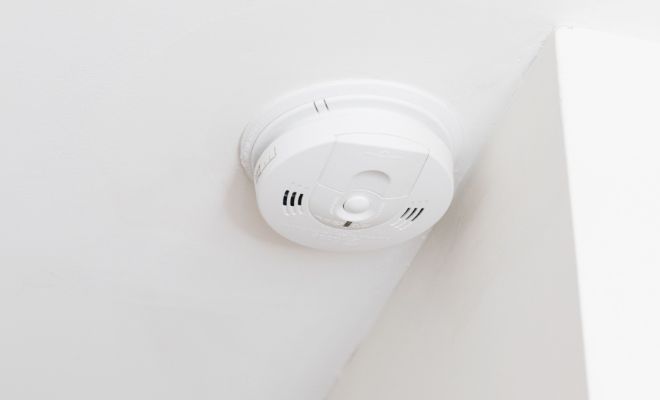
The method by which fire alarms detect the presence of fire varies between different types.
How Does a Fire Alarm Work?
An ionisation fire alarm employs a small amount of radioactive material to ionise the air between two electrodes within the alarm. This creates an electrical current.
When the smoke particles from a fire enter the chamber of the fire alarm, the current is disrupted, and the alarm is activated. These alarms are very sensitive to small smoke particles, and as many people are familiar with, can be triggered by such things as burning toast.
For this reason, they should not be sited too close to a kitchen. Optical fire alarms are more effective at detecting larger smoke particles that come from smouldering fires and work by using the light scatter principle.
This is achieved by emitting an infra-red LED light beam into the alarm chamber every ten seconds or so. The chamber also contains a photodiode light receptor. When smoke enters the alarm, it causes the infra-red light to be diffused onto the photodiode light receptor.
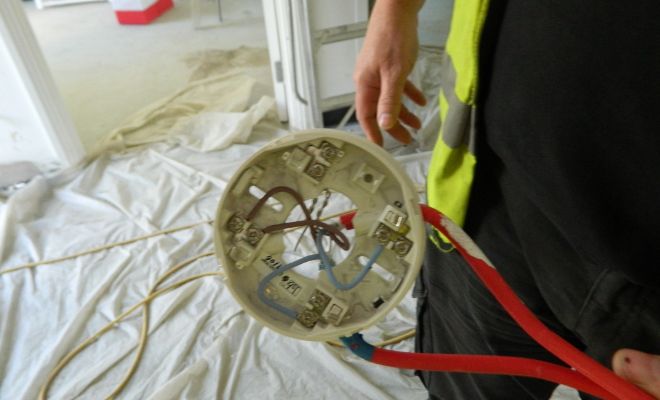
A signal is then sent to the integrated circuit to activate the alarm. These alarms are less prone to false alarms due to cooking fumes due to the way they function and can be placed in hallways on the ground floor.
They are less sensitive to small smoke particles from burning paper and wood but effective at picking up smouldering furniture fires or overheated wiring. A combined optical smoke and heat alarm can increase the speed of detection of a fire while reducing the instances of false alarms.
These alarms reduce the need for more than one alarm, although for fitting in a kitchen a heat alarm only should be used. Combining multiple sensors allows for a combined smoke and carbon monoxide alarm to be fitted in one unit.
These alarms are ideal for use in a home with gas or solid fuel heating or cooking facilities. Carbon monoxide poisoning and smoke inhalation are two of the biggest risks in the home, and these alarms will activate two different warning sounds depending on the source of the danger.
Installing a Fire Alarm
The most popular fire alarms remain battery-operated models that can be fitted by anyone in their home.
However, at least one mains wired fire alarm has been required since 1992 in newly built properties.
For loft conversions, a hardwired and interlinked fire alarm system is required in the stairwell at every level.
Positioning
The first decision when installing a fire alarm will be what type of detectors to use, and this will largely determine where they will be positioned in the property, e.g. heat alarms in the kitchen, smoke detectors in the hallway and bedrooms etc.
Battery or Mains Operated?
You will also need to decide whether to have battery-operated alarms or mains wired with battery backup.
If you decide to have mains wired, then positioning may be dictated by existing wiring.
Cost Affecting Factors of Installing a Fire Alarm
There are several factors which will influence the fire alarm system cost.
Type of Fire Alarm
The type of alarm chosen will affect the cost. This also includes the various detection methods employed by alarms as well as how they are powered.
Size of Fire Alarm System
The fire alarm system cost will also depend on the number of individual alarms that you install.
At a minimum of one per storey or level of the property, this will be relatively cheap.
However, the safety of lives and protection of property may prompt the installation of an alarm in every habitable room. This will obviously cost more than the minimum recommendation, but the peace of mind and protection that it offers may be worth the additional cost.
Mains wired systems with battery backup and interlinked alarms in all rooms will offer the best reassurance, but the cost of materials and labour will be more than one or two battery-operated fire alarms.
Post Installation Making Good
If you decide to have a mains operated interlinked fire alarm system installed in your home, there may be additional work that needs to be done afterwards. Any wiring that needs to be routed through walls will cause superficial damage to the wall, which will require repair and re-decoration.
Most fire alarms are ceiling mounted so wiring can be fed through the ceiling and concealed, but combined smoke and carbon monoxide alarms can be wall-mounted. Any wiring to the alarm is usually cut into or ‘chased’ into the wall.
The making good of this work will depend on the material that the wall is made from, but it will typically be plaster or plasterboard. This may require hiring a plasterer to repair the wall, and following this re-decoration will be needed.
This additional labour will obviously add to the fire alarm installation cost. A plasterer will cost approximately £20-25 per hour, and a decorator will charge around £15-£20 per hour.
Location of Property
Where your home is located in the UK will have an impact on the fire alarm system cost, especially if you are hiring an electrician to install a hard wired system for you.
Labour costs in London and the south-east of the country are higher with an electrician in the capital typically charging between £80-£120 for the first hour and on average £40-£60 per hour thereafter.
This compares to around £60-£80 for the first hour in the rest of the country with subsequent hours charged at approximately £30-£40.
Ease of Installation
The most straightforward fire alarm system to install is the battery-operated type which is typically attached to the ceiling with screws and are ready to use in minutes.
This type of alarm is what most people install on a DIY basis in their homes, and there are rarely issues accessing the installation point. If you choose to have a mains wired interlinked fire alarm system, then this will need to be done by a qualified electrician.
The majority of fire alarms are fitted on the ceiling, and this will necessitate access to existing wiring. How accessible this is and the work involved to reach it will influence the price that you will pay for labour.
Re-routing cables or climbing into the loft to fed wiring through will be time-consuming, and this will be reflected in the cost of the fire alarm system and installation.
DIY Fire Alarm
Most people will be familiar with battery operated fire alarms fitted on landing ceilings and in hallways, these are usually installed as a DIY task.
However, a mains-operated fire alarm system must be installed by an electrician.
Professional Installation
Any wiring or electrical installation in a property must be done by someone who understands it and is qualified to carry out such work. Attempting to install electrical equipment without adequate knowledge, training, or expertise puts lives and property in danger.
This is especially true when the equipment itself is designed to save lives by giving adequate and timely warnings of fires. It is not worth the saving in monetary terms if your fire alarm system fails to work because it has not been professionally fitted.
Or worse, you inadvertently cause a fire through a DIY installation of a mains-operated fire alarm.
Saving Money
There are DIY friendly battery operated fire alarm systems and also some that require only the first smoke alarm to be hardwired with the rest linked by Wi-Fi.
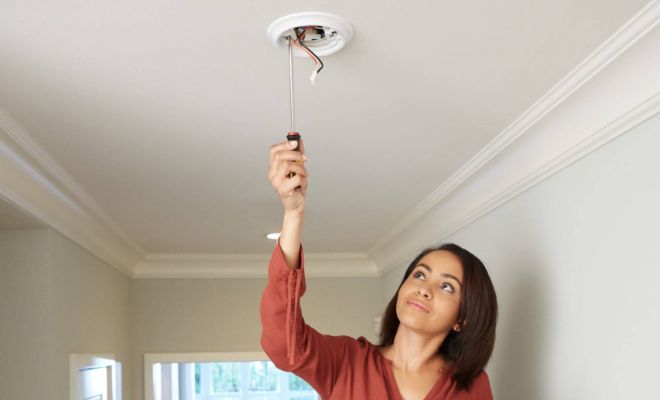
If you decide on one of these interlinked systems, you could save money by hiring an electrician to hardwire the initial fire alarm and then install the rest of the wireless units yourself.
You could potentially save around £80-£120 by doing the majority of the installation of the wireless alarms as a DIY job. As there is no wiring involved, it will not need to be signed off by a professional.
Tools Needed for DIY Installation
The tools required to install a battery-operated fire alarm are:
- Screwdriver
- Tape measure
- Pencil
Dangers of DIY
Installing a battery-operated fire alarm or wireless interlinked alarms is quite safe and does not usually require personal protection equipment.
However, if you are working from a ladder, you should ensure that there is someone around to hold it steady for you as you work.
Choosing a Fire Alarm
Several things will influence the type of fire alarm that you choose for your home; the size and layout of your home, the number of occupants, your budget and even the kind of heating and cooking facilities that you have.
Ionisation Alarms Cost
Ionisation fire alarms are the most common kind of smoke alarm and will pick up the small smoke particles released by burning wood, paper and even from a chip pan fire. These are called fast-burning fires which ignite and spread quickly.
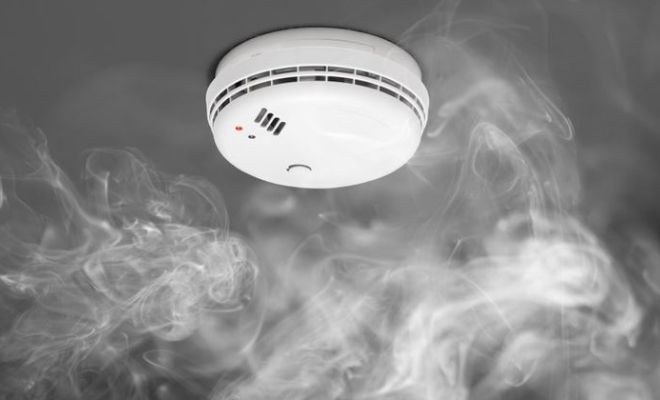
A small amount of a radioactive element between two electrically charged plates ionises the air inside the alarm chamber, causing an electrical current to flow.
The infiltration of smoke into the chamber disrupts this flow and activates the alarm. The average cost of an ionisation fire alarm is £5-£6 for battery operated and £12-£14 for a mains wired model.
Advantages of an ionisation fire alarm:
- ✔ They are the cheapest variation of fire alarm.
- ✔ Detect fast burning fires quickly.
- ✔ Easy to install as battery operated models.
Disadvantages of an ionisation fire alarm:
- ✖ Prone to false alarms from cooking.
- ✖ Do not quickly detect smouldering fires.
- ✖ Can also be set off by high humidity.
Optical Alarms Cost
Optical fire alarms are also called photoelectric alarms due to the way they work. An infra-red beam of light is pulsed into the chamber of the alarm approximately every ten seconds.
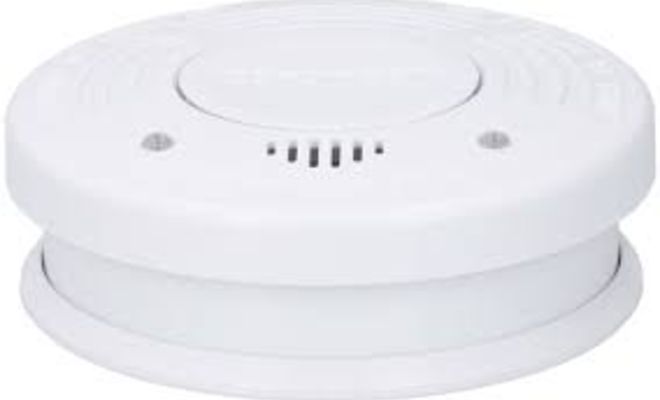
When smoke enters the alarm, it scatters the light from the infra-red LED beam onto a photodiode light receptor. This sends a signal to the integrated circuit causing the alarm to sound. The average cost of a battery operated optical fire alarm is £14-£15 while a mains-powered optical fire alarm is £20-£25.
Advantages of an optical fire alarm:
- ✔ More responsive to smouldering fires such as furniture and carpet.
- ✔ Can be combined with heat alarms and carbon monoxide detectors.
- ✔ Optical fire alarms continue to be refined and improved.
Disadvantages of an optical fire alarm:
- ✖ More expensive than ionisation fire alarms.
- ✖ Less sensitive to fast burning fires such as wood, paper, or chip pan fires.
- ✖ Not suitable for kitchens or garages.
Heat Alarms Cost
Heat alarms are made to detect heat as opposed to smoke, and they do this through a device inside the alarm called a thermistor. This is a type of resistor which reacts to increased heat.

When the temperature inside the alarm exceeds 58°C through rising hot air, the thermistor activates the alarm. The average cost of a battery operated heat alarm is between £10-£15 and for a mains-wired heat alarm between £20-£25.
Advantages of a heat alarm:
- ✔ Can be used in a kitchen and garage.
- ✔ Used in combination with an optical smoke alarm can detect both risks.
- ✔ No false alarms as they do not react to smoke or cooking fumes.
Disadvantages of a heat alarm:
- ✖ Uses are restricted to garages and kitchens.
- ✖ Relatively expensive.
- ✖ Only covers a small area so more than one may be needed for large kitchen or garage.
Combined Optical Smoke & Heat Alarm Cost
Having two detectors in one unit saves money, space and potentially lives. A combined smoke and heat alarm does exactly what it says; it detects separately the two products of a fire: smoke and heat.
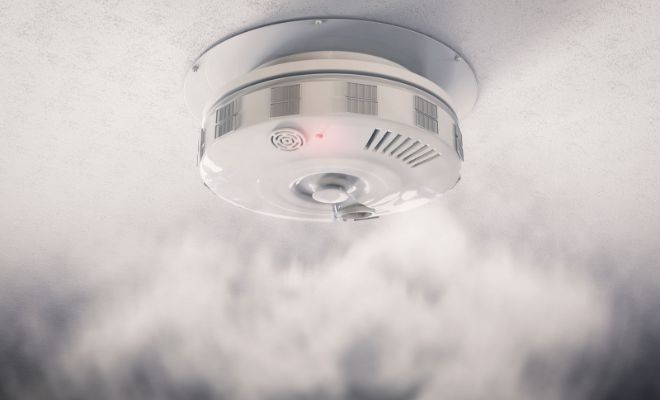
The average cost of a battery operated combined optical smoke and heat alarm is £25-£30 and £55-£60 for a mains wired model.
Advantages of a combined optical smoke and heat alarm:
- ✔ Increases the speed of detection of a fire.
- ✔ Reduced risk of false alarms.
- ✔ Suitable for all areas of a property.
Disadvantages of a combined optical smoke and heat alarm:
- ✖ Expensive, costing as much as buying two separate alarms.
- ✖ Does not detect fire as quickly as an ionisation fire alarm.
- ✖ The optical smoke alarm is prone to interference in dusty environments.
Combined Smoke & Carbon Monoxide Alarm Cost
In properties where there is a gas or solid fuel heating or cooking facility, a carbon monoxide detector is required. Combining this with a smoke alarm provides additional safety protection.
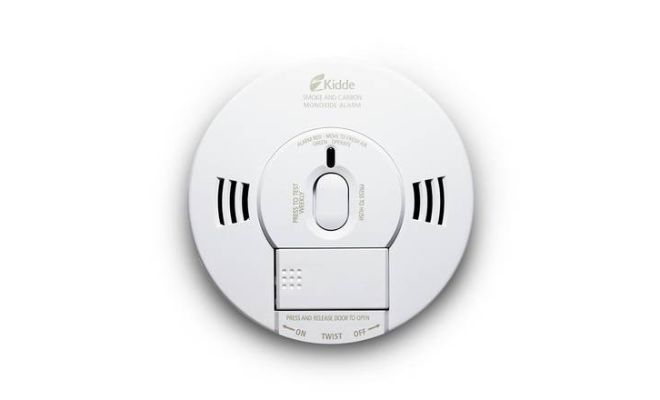
The average cost of a battery operated combined smoke, and carbon monoxide alarm is £25-£30 and a mains wired version will be between £45-£55. Whichever fire alarm you buy you should ensure that it is certified to either British or European Standard.
Advantages of a combined smoke and carbon monoxide alarm:
- ✔ Saves space by combining two detectors into one unit.
- ✔ Risks from carbon monoxide poisoning and from fire are significantly reduced.
- ✔ Voice warnings reduce risk of confusion about which danger is detected.
Disadvantages of a combined smoke and carbon monoxide alarm:
- ✖ Can be more expensive than buying separate alarms.
- ✖ Positioning is a compromise as smoke detectors work best on the ceiling and carbon monoxide detectors work best on the wall at head height.
- ✖ Some people prefer the reassurance of two separate detectors.
Benefits of a Fire Alarm
There are many benefits to installing a fire alarm, some of which may seem obvious and others are not so evident.
Early Warning of Fire
The primary function of a fire alarm is to provide an early warning to occupants of a building that there is a fire present. This allows time for the evacuation of the premises as well as the opportunity to try and save as much property as possible through fire suppression.
Safety of Occupants
Preserving life is the predominant reason that most people install a fire alarm in their home. To keep their family safe and to have the peace of mind that if a fire should break out that they will be given adequate warning and opportunity to leave safely and without injury.
Protecting Property
Preventing the spread of fire to other parts of a building and neighbouring premises is also a beneficial factor in installing a fire alarm.
Protection While Sleeping
Fires which occur at night are perhaps the most dangerous as smoke inhalation kills more people than fire itself.
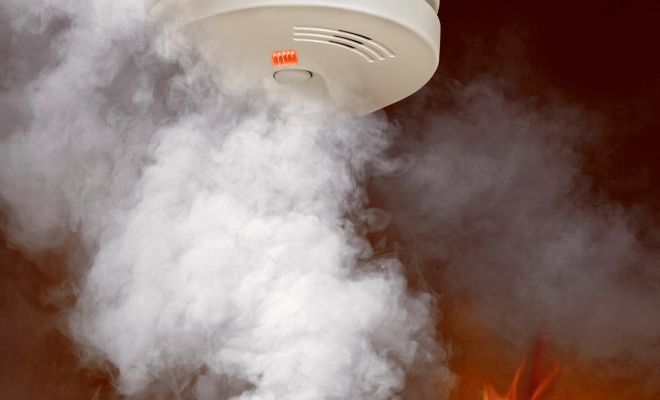
The presence of a loud warning system will wake those who may otherwise succumb to fumes and smoke while sleeping.
Budget Friendly
Fire alarms are affordable with ionisation alarms costing as little as £5; therefore, the benefit of having an early warning system is available to the majority of households in the UK.
Small but Essential
The size of a fire alarm means that they can also be placed in every room of the house without encroaching on space too much, thus providing widespread coverage.
Convenient
Modern fire alarms are often fitted with batteries which last up to ten years, so there is no need to keep changing the battery or worry about it running down. With hard wired fire alarms, this is not an issue, and most have a battery back up in the event of a power cut.
Insurance Premium Reduction
Fitting fire alarms in your home could reduce your home insurance premiums, but you should check with your insurance provider to see if they specify a particular type of alarm.
Building Regulations and Planning Permission for Fire Alarms
Here's some information on building regulations and planning permission for fire alarms:
Fire Safety Building Regulations
The government’s Approved Document B on fire safety was restructured, and the use of plain English as opposed to technical speak was introduced in 2019 to clarify requirements on all aspects of fire safety.
It includes provisions for the installation of early warning systems for fire and states that all dwellings should have fire detection and an alarm system.
Requirements for Mains Wired Fire Alarm
Since 1992 Building Regulations require that any newly built property must have at least one mains wired fire alarm installed with a battery backup in the event of a power failure.
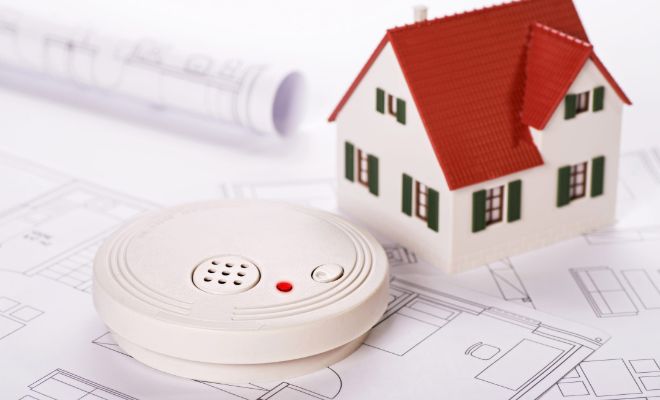
Also, the addition of a loft conversion or ground floor extension with new habitable rooms to an existing property will require a fire alarm to be installed.
Proper Installation & Maintenance
Building Regulations also state that “fire detection and alarm systems must be properly designed, installed and maintained”. /p>
Regular checks of your fire alarm should include pushing the test button to ensure it is in good working order at least once a week, keeping it free from dust and obstruction and changing the battery as and when required.
Planning Permission
Planning permission is not required for the installation of a fire alarm system.
To find out what is required for compliance with Building Regulations concerning fire alarm systems, you can visit the government website.
Removing a Fire Alarm Cost
You may want to remove a fire alarm if you are replacing it with a newer version or carrying out renovation or refurbishment work.
If the fire alarms are battery-operated, then removing them should be a simple process of taking the main body of the alarm off of the back plate and then unscrewing the backplate from the ceiling. If you are not replacing the alarm in the same place, then you may want to make good the fixing holes by filling them in and redecorating.
Who Can Remove a Fire Alarm?
If the fire alarm system is hard wired, then its removal must be done by a qualified electrician to avoid injury or electric shock.
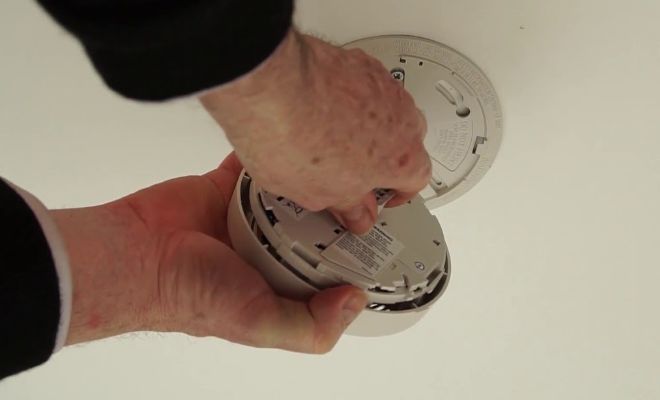
Hiring an electrician to do this work will cost on average between £70-£100 for the first hour and approximately £35-£50 for every hour afterwards.
Disposal
To dispose of your old fire alarms, it is best to contact your local authority and ask where you can dispose of them.
Some waste and recycling centres will not take ionisation alarms as they contain a small amount of radioactive material and so are classed as hazardous waste.
If you hire an electrician to remove mains wired fire alarms, they may be willing to dispose of them for you for a small fee but ensure that they will do so legally and safely before agreeing.
FAQs
Hard wired alarms with battery backup will also do this if the battery needs replacing.
A fire alarm sound is lower in tone but higher in volume and may sound at random intervals. The sound of a fire alarm is usually too loud to ignore.
However, both types are used in different parts of a property, and both carry out vital functions as fire safety and early warning systems.
It is not the responsibility of the tenant to install fire alarms, and any property which does not have the minimum recommended fire alarms should not be rented out.
Most fire alarms can be tested by pushing the ‘Test’ button on the main body of the alarm.
How to Find & Hire a Fire Alarm Installer
The type of fire alarm that you wish to install in your home will define which tradesperson you will need to carry out the work. An electrician will be required for a hard wired system. Still, a battery operated fire alarm can be fitted by a suitably competent person without the need for specific trade qualifications.
However, you should be happy that the person knows what they are doing, has done similar work before and will install the fire alarm properly so that it operates as it should. You should always be comfortable with the person working in your home, and this can be particularly important for women who live alone.
Personal recommendation is a good way to find a competent and reliable installer for your fire alarm.
Qualifications
For the installation of a battery operated fire alarm system it is not necessary to hire an electrician and the work can be carried out by a general builder or handyman. However, you should still be confident that they are qualified to carry out the work and have the necessary experience to do it properly.< /p>
Needless to say, for a hard wired fire alarm system, a qualified electrician is the only person who should be carrying out this work. You can check the qualifications of an electrician on the NICEIC website.
The NICEIC is the National Inspection Council for Electrical Installation Contracting and regulates the training and work of electricians and electrical contractors in the UK.
References & Proof of Previous Work
Some homeowners feel uncomfortable asking a tradesperson for references or proof of similar previous work, but a professional will completely understand your need to do this and not be offended.
Check Insurance Cover
The same is true for asking for proof of insurance, such as public liability or professional indemnity. This may be particularly important with the installation of electrical equipment such as a fire alarm system which is designed to save lives and property.
Get More Than One Quotation
For any work in your home that requires a professional, it is sensible to get quotes from at least two or three people before you hire someone. This allows you to get a feel for the average cost of the work as well as the comparable knowledge and competence of different tradespeople.
Although you may be happy with the first person who quotes to carry out work in your home, it is wise to resist the temptation to hire them immediately. While they may be capable, competent, and knowledgeable, most professionals understand the importance of getting quotations from more than one source.
There are many things to consider before hiring, of course, competence and skill are critical, but you should also feel comfortable having someone in your house. So, take the time to meet and discuss the work with at least two or three different tradespeople before making a decision.
Sources
https://www.fireangel.co.uk/the-different-types-of-fire-alarms-and-where-to-install-them/










